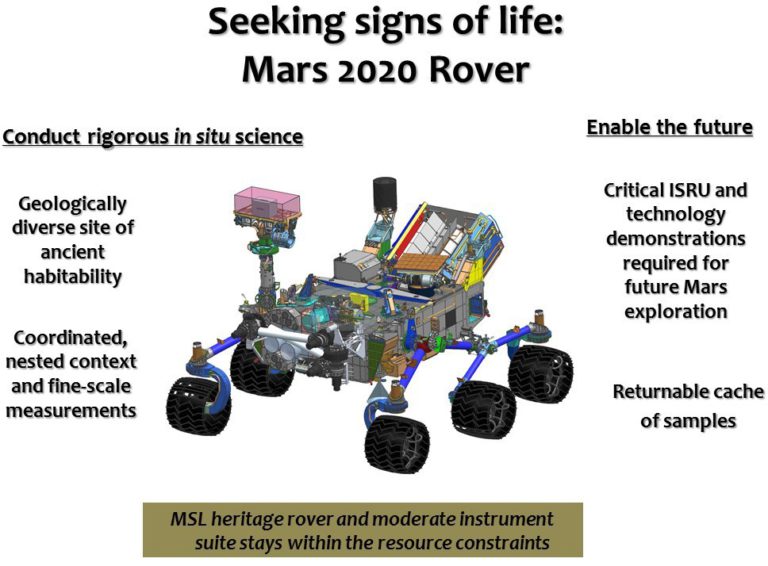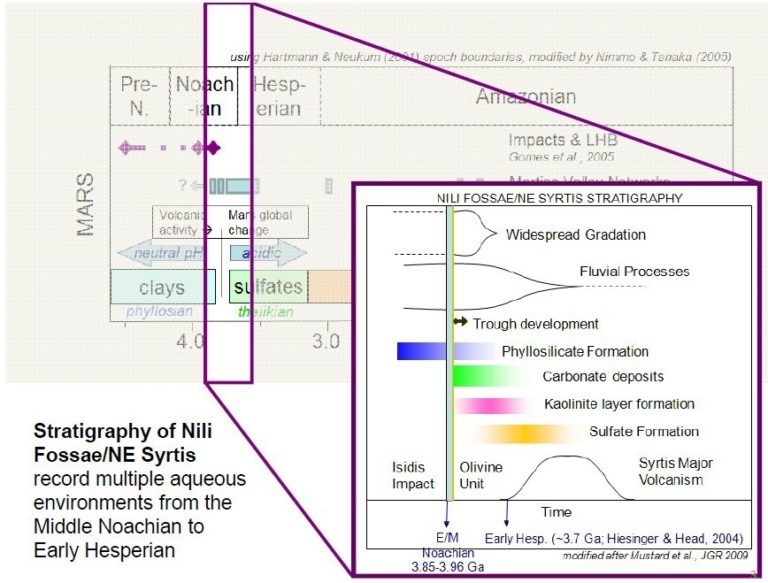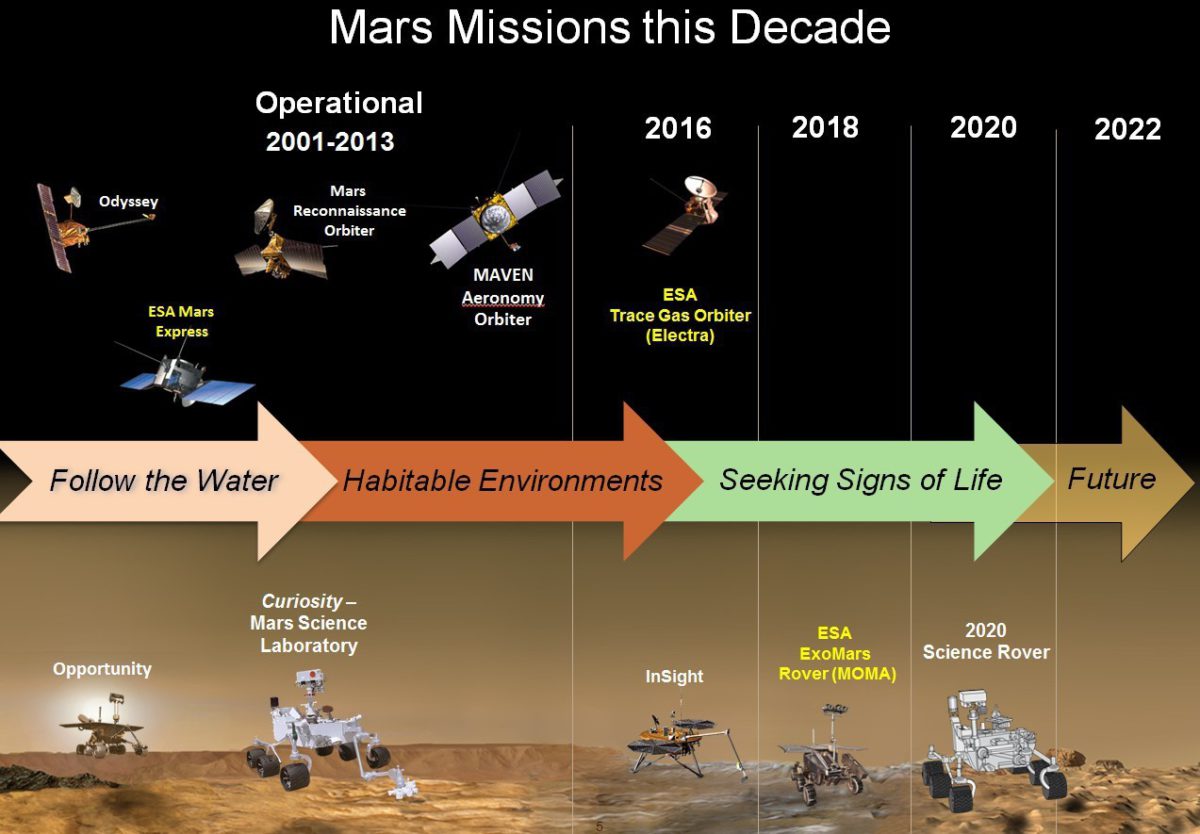Van Kane • Jun 09, 2014
A Checkup on Future Mars Missions
We have enjoyed two decades of increasingly more focused exploration of Mars. After a lull of twenty years, the 1996 Mars Pathfinder lander began what has become a flotilla of orbiters, landers, and rovers to examine the Red Planet in increasing detail. Missions in flight or in development will explore the processes that are stripping away the atmosphere, measure its trace gases, and study the interior of another planet for the first time. Two missions will land rovers to poke and prod two locations in detail. This is in addition to the three orbiters and two rovers currently exploring this world. Only for our moon do we have such a rich understanding of another world.
The MEPAG meeting last month included the usual program review, but it also coincided with the second workshop in the long selection process for the landing site for NASA’s 2020 rover mission. In this post, I’ll share highlights from the two meetings. (You can read the presentations here.)
The European Space Agency (ESA) has an active Mars program with the Mars Express orbiter currently at Mars, two ExoMars missions in development, and planning under way to select follow on missions. It will jointly develop and fly the two ExoMars missions with the Russian space agency Roscosmos. The first, set to launch in 2016, will have an orbiter that will focus on atmospheric chemistry and dynamics along with a small European technology demonstration lander. The second, to launch in 2018, will deliver a highly capable rover and station that will search for signs of past or present life.
The current tensions between the U.S. and Russia over Ukraine have the potential for disrupting these missions. NASA plans to deliver its Electra communications package for the 2016 orbiter that will allow it to relay data from surface landers and rovers back to Earth. Both ESA’s 2018 ExoMars rover and NASA’s 2020 rover missions plan to use the ESA orbiter to relay data back to Earth. Because Russia will launch the mission, shipping equipment to Russia with the current political tensions over Ukraine may prove difficult. With launch just two years away, there’s little time to recover from any delays if they occur. NASA also plans to deliver a key parts of one of the 2018 rover’s instruments, but there is more time to deal with that issue.
Other highlights from the ESA presentations:
- Both the 2016 and 2018 missions are on track other than the potential export issue (although no mention was made of whether or not funding has been fully secured for the 2018 mission, which has been an open question).
- Russia is still scheduled to provide the key entry, descent, and landing system for the 2018 rover. This will be a major project for a space agency that hasn’t had a successful planetary mission in decades.
- Russia plans to host a surface station in the 2018 lander platform for long-term studies of the atmosphere and geophysics of Mars. Instrument selection will begin this spring.
- ESA is considering three missions to follow the 2018 rover. The current favorite, Phootprint, which might launch in 2024, would be a possible third joint mission with Russia and would return a sample from the Martian moon Phobos. Other options would be for three small geophysical landers to establish a network to study Mars interior or a small rover to explore a new region of Mars.
Japan’s space agency, JAXA, is considering several mission options for a future Mars mission, but has no currently approved Mars missions. (Its only previous attempt to reach Mars, the Nozomi orbiter, failed.) For its next try, JAXA’s managers are considering several small missions including an engineering demonstration to use the atmosphere to slow the spacecraft to enter orbit (aerocapture), an airplane to survey magnetic anomalies this will provide clues on Mars’ ancient but now defunct magnetic field, and a meteorological station or seismic station. The presenter, however, spent the most time describing the most ambitious concept, a rover that would be smaller than the Opportunity rover at ~60 kilograms. Two goals for the rover were described in some depth – an environmental package to study dust movement by the atmosphere (including dust devils) and a relatively simple microscope that would use fluorescence to detect biosignatures in the soil. Launch would be sometime in the 2020s.
A presentation on the NASA MAVEN mission that will study loss of the atmosphere into space gave the good news that all is well with the craft. It arrives at Mars on September 21st this year.
The Europeans and Russians will not have the only mission to Mars in 2016. NASA’s InSight geophysics station will launch that year to study the interior of Mars. The lander also will carry a capable weather station to enable scientists to determine the influence of temperature and winds on its measurements. The InSight mission has always planned to carry a camera to aid in instrument deployment, with one panorama planned early in the mission. The project will attempt to replace the currently planned black and white camera with a color camera, but there are no promises. The mission development is proceeding well and the team has received permission to start hardware development following an in-depth review of the design.
The focus for the two meetings, though, was NASA’s 2020 rover. Like the Curiosity rover currently on Mars, the 2020 rover will pursue the question of whether Mars could have hosted life in the past (or even in the present). While the Curiosity rover does that only with the scientific instruments it carried to Mars, the 2020 rover also will select and cache 25+ rock and soil samples that could be returned to Earth for study with much more sensitive instruments in terrestrial laboratories.

NASA plans to build and fly the 2020 mission for just half the cost of the Curiosity mission, adjusted for expected inflation. The need to collect samples and control costs will ripple through portions of the mission plans. (An additional new goal, to gather measurements and test hardware that would be useful to a future human mission will also drive some changes.)
One portion of the mission that will be familiar will be the design of the rover and the hardware that delivers it to Mars. NASA believes that up to 90% of the Curiosity mission’s design (by mass) can be reused (which enables a highly capable mission at bargain price). Some changes will fulfill the new mission requirements (for example, the caching hardware) and others will apply lessons gained in operating Curiosity (for example, beefier wheels after Curiosity’s showed unexpected early wear).
The instrument suite the 2020 rover will carry is likely to be substantially different from Curiosity’s. Curiosity carries instruments that both can make quick measurements to rapidly assess the geology of a location and a highly capable laboratory that can make detailed measurements. The latter, though, is costly both in dollars and in the time needed to make the measurements. In almost two years of operation, Curiosity has collected just three samples for its laboratory instruments. In that same time for the 2020 mission, scientists want to fill most or all of their cache. As a result, the 2020 rover may carry only rapid assessment instruments in addition to its caching system (although technology advances may mean that some will be much more capable than their Curiosity equivalents). NASA is expected to announce the instrument selection this July.
The desire to cache samples also is leading scientists to prize the diversity in evaluating landing sites. Scientists want its samples to represent the broadest range of ancient environments and processes as possible. While almost half of the Martian crust is older than 3.7 billion years when life might have formed (compared to less than 1% for the Earth), many of those locations would provide limited diversity within the range a rover could explore. (Many also would be unsafe to land at.)
At the end of the landing site workshop, the participants held a straw vote to indicate which sites they found most compelling. The winner, located on the northeast edge of the plains of Syrtis Major, illustrates the diversity they would like to find. Within a few kilometers, this site provides access to samples that record key stages of Mars’ early evolution:
- Blocks of rocks hurled from nearby massive impacts record the early bombardment of the terrestrial planets by comets and asteroids. These are also convenient samples of the ancient crust delivered from outside the landing zone.
- Ancient crust with minerals preserving the record of the early wet environments of Mars that may have provided conditions for life to develop or at least that record biotic precursors. The NE Syrtis Major site has an unusually wide range of aqueous minerals that suggest a diversity of environments that came and went across millions of years as the climate dried out.
- A nearby volcanic flow represents the massive volcanism that covered large areas of the planet in its early history. These rocks could record the chemistry of Mars’ ancient mantle, provide clues on when Mars’ ancient magnetic field shut down, and in terrestrial laboratories provide unambiguous dating of a wide-scale event to calibrate dating of Mars’ early history.

At this point, NASA is not looking to rule out any of the nearly thirty sites that have been proposed. While the NE Syrtis Major site won the initial beauty contest, other sites may prove to be more desirable with further analysis.
While NASA doesn’t need to select the 2020 mission’s landing site until 2019, two factors are pushing it to evaluate sites early. One is that high resolution mapping of the sites for geologic sites and landing hazards requires the sharp-eyed cameras of the Mars Reconnaissance orbiter. That spacecraft reached Mars in 2006, and NASA wants to make maximum use of it while it remains healthy and has an adequate fuel supply.
The mission’s engineers also want an early look at the most desirable landing sites to determine whether the 2020 rover will need a significant upgrade in its landing system. The closest the mission’s operators currently can target the lander is to an ellipse 25 by 20 kilometers. A simple design change can reduce that ellipse area by 40%. Unfortunately, the richest sites for exploration often don’t have the smooth surfaces needed to ensure a safe landing within their landing ellipses. The Curiosity rover, for example, will spend more than two years getting from its safe landing site to the starting point for its actual target area. (Fortunately, there’s been great science along the way.)
For the 2020 mission, NASA would like to avoid another long road trip at the start of the mission. If the sites of greatest interest turn out to turn out to have hazards, then NASA will consider a technology called Terrain Relative Navigation (TRN). With TRN, the landing system will compare images taken during the final descent against a stored map of safe landing zones. It will then steer the landing to one of those safe harbors. Without TRN, a mission to the NE Syrtis Major site, for example, has an 87% chance of a safe landing; with TRN the chance of safe landing increases to over 98%. However, the TRN technology would be expensive to develop and test. NASA wants to know that it is likely to be needed before committing to it for a mission that’s already being done on a bargain budget.
The two meetings showed that despite an incredible run over the last couple of decades, for Mars the best may still be to come.
Note: All the presentations promoting landing sites from the landing site workshop are available on-line. If you’re not a geologist, you may want to read Emily Lakdawalla’s posts on Mars’ geologic eras and on key minerals that suggest past aqueous environments. Wikipedia also has articles on the Noachian era and its successor the Hesperian era during which Mars’ surface transitioned from an impact ridden world, to one with possible abundant surface water, and then progressively dried out. The 2020 mission is likely to focus on sites that contain remnants from one or both of these eras (as the NE Syrtis Major site does).
Support our core enterprises
Your support powers our mission to explore worlds, find life, and defend Earth. You make all the difference when you make a gift. Give today!
Donate

 Explore Worlds
Explore Worlds Find Life
Find Life Defend Earth
Defend Earth



